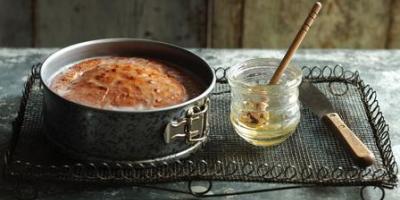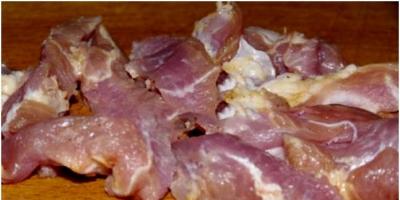It’s hard to imagine without openwork Japanese maples. More often on sale there are varieties of palmate maple - a tree-like shrub with characteristic dissected bright green leaves, reaching 5-7 m in width and height in its homeland. In autumn its leaves turn a stunning shade of orange-red. In our area, they usually have more compact sizes and require careful selection of location, soil preparation and careful maintenance.
Fan maple ‘Atropurpureum’
The most popular varieties include Acer palmatum 'Atropurpureum' with bright red, characteristically shaped leaves, especially blazing scarlet canopy, as well as 'Dissectum Atropurpureum', which, along with the purple color, has highly dissected openwork leaves and a more compact crown, reaching only 2-3 m. The maple varieties 'Fireglow', 'Bloodgood', 'Deshojo', 'Dissectum Garnet', 'Dissectum Nigrum' and others also have a purple color of varying intensity up to almost black-red. However, do not get carried away with purple-leaved plants. There should be several of them against the background of plants with foliage different shades Green colour.
Also very attractive are maple varieties with green, gracefully dissected leaves, such as ‘Dissectum Viridis’ or ‘Osakazuki’, which turn stunning shades of yellow and orange-red in the fall.
There are also many varieties of Japanese maple (Acer japonicum) known. The most popular varieties are 'Aconitifolium', the leaves of which are bright red in the spring, green in summer, and orange-red in autumn, dissected into 9-11 lobes and similar in shape to aconite, and 'Vitifolium' with deeply dissected leaves, colored in autumn carmine red tones. The magnificent sunny variety ‘Aureum’ is decorated with golden-yellow foliage and has an almost rounded, slow-growing crown.
To ensure that your maples grow well, choose a place for planting that is sheltered from cold and drying summer winds in the openwork shade of taller plants, as well as neutral or slightly acidic, fertile, moist soil. In the hot sun, in the absence of constant soil and air moisture, the leaves of Japanese maples fade, dry out and crumble. These graceful plants belongs to winter hardiness zone 6, i.e. sensitive to frost and require insulation with spruce branches or nonwoven materials, especially at a young age. Young growths damaged in winter, as a rule, are restored, but in particularly harsh and snowless winters, which often occur in the southeastern regions, the plant can die completely.
Since Japanese maples grow quite slowly, little special shaping is required, other than sanitary pruning of damaged branches, or to maintain the compact size of a container plant or garden bonsai. The plant is responsive to feeding with a solution complex fertilizers with an acidifying effect, which, however, must be stopped before the beginning of autumn, so as not to cause the growth of young, non-lignified shoots, which are especially susceptible to frost damage. To retain constant moisture and acidify the soil, mulching is recommended trunk circle bark or compost from fallen leaves and peat.
Instead of rather problematic, requiring ongoing care Japanese maples can be recommended, similar in decorative qualities, but more unpretentious species: Manchurian maple (Acer mandschuricum) and pseudosieboldianum (Acer pseudosieboldianum) are small trees or large shrubs with carved, small, palmate leaves that turn bright crimson or purple in autumn. The following species are also very interesting: sharp-toothed maple (Acer rgutum), three-flowered maple (Acer triflorum), Pennsylvania maple (Acer pensylvanicum), snakebark maple (Acer capillipes), curly or grape-leaved maple (Acer circinatum), green-barked maple (Acer tegmentosum). These species are less commonly found in garden centers and nurseries, but you can try ordering them from foreign nurseries, or contact amateur collectors or botanical gardens.
Mesmerizing bloom
It is difficult to find a gardener who does not know about the magnificent cherry blossoms. In Japan, there is even a special Hanami holiday, when thousands of people give up their everyday worries and devote time to admiring the blossoming flowers of the Japanese cherry blossoms - sakura. Botanists include in this group varieties with decorative flowering of finely serrated cherry (Prunus serrulata) and short-bristle cherry (Prunus subhirtella). The most popular decorative cherry varieties are Prunus serrulata "Kanzan" and "Accolade" - with pink double flowers, "Amanogawa" - with a columnar crown shape and double large flowers.

Sakura
Pay attention to the wonderful variety "Kiku-shidare" with a weeping crown, which will look especially advantageous on the banks of a stream, an ornamental pond, or as a free-standing tree that evokes universal admiration even after a short flowering period. In nursery catalogs they are assigned zone 6a, i.e. in the territory from the center of Ukraine and to the north, their cultivation may not always be guaranteed and is associated with additional care. So it’s worth thinking about the assortment. We can recommend the more persistent double-flowered bird cherry (Prunus avium "Plena"), the cherry blossoming with white and pink flowers Prunus schmittii, the decorative plum Prunus cerasifera "Woodii" (almost the same as the Pissardi plum) or the already traditional and beautifully flowering three-lobed almond, which is offered as a grafted standard tree(P. triloba plena)
In the central and northern regions (zones 3-5) as flowering tree it is better to choose varieties of ornamental apple trees with different flower colors: white in “Evereste”, “John Downie”, “Golden Hornet”, “Professor Sprenger”, various shades of pink - “Hopa” and up to purple - varieties “Royalty”, “Liset”, "Eleyi", "Almei", "Rudolf") and even double ones, like the "Van Eseltine" apple tree.
Niedzvetsky apple tree
Beautiful hawthorn trees are also suitable - with white flowers, our endemic hawthorn (Crataegus monogyna), a double variety of hawthorn Crataegus laev. "Plena", as well as varieties with bright pink double flowers - Crataegus laevigata "Paul's Scarlet" and "Crimson Cloud" - with red flowers. Their autumn color from yellow to red is also magnificent, which can compete with the outfit of Japanese maples, which also important in seasonal dynamics Japanese gardens.
For small gardens, we can also recommend large flowering and decorative foliage shrubs, which, depending on the formation, can grow as small trees: Canadian serviceberry (Amelanchier canadensis), exochorda (Exochorda macrantha "The Bride", winged euonymus (Euonymus alatus "Compactus) with a wonderful autumn color "), Viburnum lantana (Viburnum lantana). To extend the decorative effect of your garden, do not forget about evergreen shrubs: Viburnum rhytidophyllum, Mahonia aquifolium, Pyracantha coccinea, Fortune's euonymus (Euonymus fortunei), of course , O coniferous plants: mountain pine (Pinus mugo), yew (Taxus baccata), drooping arborvitae (Thujopsis dolabrata).
An interesting accent to the winter garden can be shrubs with unusually shaped stems, intricately curved, like the willow Salix udensis "Sekka" or the hazel Corylus avellana "Contorta".

Chaenomeles
In the lower tier under the trees you can plant discreet, graceful shrubs with beautiful flowers and leaves that will provide a seasonal change of colors and moods: numerous wonderful varieties of Japanese spirea (Spiraea japonica) and c. Bumalda (Spiraea bumalda), Nippon spirea (Spiraea nipp. "Snowmoun"), stephanandra (Stephanandra incisa "Crispa") and snowberry (Symphoricarpos chenaultii), Japanese quince (Chaenomeles japonica), horizontal, shiny and Dammer cotoneasters (Cotoneaster dammeri ), tree peony (Paeonia suffruticosa), tree hydrangea (Hydrangea arborescens), kolkwitzia amabilis, viburnum leaf hydrangea (Physocarpus opulifolius).

Tree peony
Various species and varieties of rhododendrons are considered traditional for Japanese gardens, but they generally grow well only on acidic soils and in most of Ukraine they suffer from dry air and frosty winters with little snow. Growing them is possible, but will require additional measures on soil preparation and careful care.

An indispensable element of a Japanese garden are considered to be specially formed coniferous or deciduous bonsai plants, or more precisely nivaki, that are specially formed by pruning. Now in garden centers you can buy ready-made bonsai for every taste, however, this is a very expensive pleasure. In addition, be sure to ask what plant the bonsai is formed from. In nurseries in Western Europe, where they most often bring them to us planting material, very often for shaping they use fast-growing crops that do not winter well in our conditions, or suffer from the summer heat, which will require a lot of attention, care or frequent pruning to maintain shape: Lawson cypress and pea, Japanese hollies, holly, etc. (Ilex aquifolium), cherry laurel, Japanese privet (Ligustrum japonicum), Japanese euonymus, beech, hornbeam, etc.

Meanwhile, it is quite possible to try to form a fairly high-quality accent for your Japanese garden from mature shrubs or conifers already growing in your garden. Lessons for beginners can even be found on the Internet. Arm yourself with pruning shears and materials for fixing the branches in the desired position, take a close look at your plants and start cutting. It’s not for nothing that they say “it’s not the gods who burn the pots.” In the simplest case, with the help of pruners, the skeletal branches of the first order are freed from lateral branches to a certain height, forming pre-designated tiers, and then several short shoots are left at the top of each branch to form a “cloud”. The skeletal branches are stretched horizontally and secured with strings, wooden slats or bamboo stems. The shape is then maintained throughout the season by regular pruning. Suitable for haircuts a large number of shrubs, preferably initially with small foliage or needles and a compact habit, for example varieties of prickly and European spruce, mountain and Scots pine, yew, Virginia and Chinese junipers, from deciduous trees, barberries, shadberry, European euonymus, endemics of our forests field maple ( A. campestre) and Tatarian maple (Ácer tatáricum), hawthorn (Crataégus monógyna), privet (Ligustrum vulgare), etc.

Astilbe

Forest anemone
Perennials and groundcovers will complete the picture: apical pachysandra (Pachysandra terminalis), Tiarella wherry and heartleaf (Tiarella cordifolia), hosts, preferably not very large and not variegated, for example hosta lanceolate (Hosta lancifolia), loosestrife (Lysimachia nummularia) , columbine fan (Aquilegia flabellate), heuchera (Heuchera .sanguinea), kupena (Polygonatum hybr.), Chinese astilbe (Astilbe chinensis). The bryozoan (Sagina subulata) will cover the ground and the spaces between the stones with a green velvet carpet. Be sure to plant irises, beloved by the Japanese, on the banks of a pond or stream.

Traditional Japanese irises - hana-shobu (Iris ensata, Iris kaempferii) are not easy to grow in our climate (although new rather unpretentious varieties have appeared), but in decorativeness they are not inferior to the graceful varieties of Siberian iris (Íris sibírica) or dwarf iris (Iris pumila) in combination with spring primrose (Primula veris) and bergenia (Bergenia cordifolia).

Badan
I hope everyone will agree that the most important thing in creating your own “Japanese” garden is not to flawlessly reproduce other people’s creations, but to enjoy the very process of creating a garden, and then from contemplation, admiration and even pride in the creation of your own hands. First of all, you and your loved ones should like the garden as a whole and each of its elements. Then, for sure, your kindergarten will achieve the goal that world-recognized masters strive for: to gain a sense of unity with nature, to become a place of harmony and inspiration, a way of self-expression, and therefore will ensure a good mood, well-being in the home and success in work.
Victoria Roy
landscape designer
especially for the Internet portal
garden center "Your Garden"
How good
When, waking up at dawn,
Look out into the garden -
And suddenly you see that the buds
turned into flowers on a cherry tree.
Tachibana Akemi
Peonies are more suitable than the traditional ones in our gardens - large-flowered ones terry varieties, but wild species or varieties of Japanese selection. Thin-leaved peony, Veitch peony, Delavey peony and, of course, tree peonies will fit well.
Speaking about plants for the Japanese garden, one cannot fail to mention, of course, the traditional Japanese wild cherry. Among the flowering tree and shrub plants, magnolias are also suitable, Japanese quince, felt cherry, forsythia.
In addition to the listed groups of plants, the eastern corner can be decorated with many cereals, trees, shrubs and herbaceous plants that have successfully taken root in Russian latitudes. So, in the shade you can plant various ferns, mosses and hosts.
For creating Japanese garden it is important to feel it, to feel the harmony of the changing seasons and the subtle symbolism of each of the elements used in such compositions. And then concrete solutions they will come by themselves. And whether these plants come from the Japanese islands or trees and herbs that are more traditional in our latitudes is no longer so important.
A garden can have a variety of purposes: it can be arranged for contemplation, harmoniously combining stones and plants, a garden for relaxation with the whole family, which is usually organized according to the patio principle, a park for sports competitions with a perfectly flat emerald lawn, or the one closest to us kindergarten with high fruitful trees. Today, many areas of our lives include the cultures of other countries, including the cultural characteristics of Japan.
When creating a Japanese garden, you must remember that this style involves the use maximum quantity natural and natural materials.
Besides Japanese cuisine, cinema and entertainment, Japan has revealed to us the amazing art of creating a Japanese garden, whose harmony and consistency of details amazes our aesthetic perception.
If you like Japanese landscape design and want to enjoy the beauty of a Japanese garden in your suburban area, then you should first find out what exactly this creation of Japanese art should be like and how to choose the right plants for a Japanese garden.
How to plan a Japanese garden on your site?
The stages of garden planning and its design in the Japanese style are not very different from the European garden, but it would be better to consider them in more detail in order to learn how to correctly place emphasis on each of the stages of garden design.
First of all, to create a Japanese-style park on your site, you should determine its design, purpose, content and location.
Return to contents
Japanese garden and its types

Scheme for creating a water bowl in a Japanese garden.
The first gardens in Japan served a purely landscape function. In the course of their evolution, they became a place for religious and philosophical reflection. This is the Dzedo Garden, the design of which necessarily includes a lake with a broken shoreline, islands and a temple. Over time, the design of Zen gardens appeared, which were monastic and temple. The design allowed for a complete absence of plants in these parks, which gave way to sand, pebbles and stones. Tea ceremony gardens are also Zen gardens. These kindergartens have always been large sizes, with a bench, a path, a special tsukubai vessel, which is intended for washing hands, and an oribe - a stone lantern.
A Japanese garden in the “dry landscape” style was arranged as follows: on fine gravel or sand, which symbolized water, parallel furrows were drawn with a special rake, which symbolized the running of waves on the water.
In the 19th century, Japanese landscape art introduced the design of miniature gardens called tsuboniwa, which were located near residential buildings. There are tsukubai and oribe, paths, a stone step at the entrance and a minimal number of plants. This garden is designed to emphasize the unity of man from nature and shows the immensity of the universe in a small area.
Return to contents
How to choose the right plants to create a Japanese garden?
The Japanese garden considers the world of plants in the same way as the park, as a whole. Moreover, the symbol of variability of the universe (yin) are flowering, deciduous shrubs and trees, and the symbol of constancy (yang) are evergreen plants.
Plants for a Japanese garden are selected, as a rule, with flowers of the same color and green leaves. The texture and shape of the leaves is very important. Bright colors are not very common in gardens; variegated and red-leaved forms are very rarely planted in them; it is enough that the leaves of plants change color in the fall. The most original things in this park are topiary figures, molded plants and bonsai. A variety of umbrella and weeping forms of plants have a very impressive appearance, but you can get carried away with mixing various forms it’s not worth it, since traditionally Japanese gardens have homogeneous wood compositions, which creates harmony.
Return to contents
Selection of woody plants

The choice of shrub and tree forms of plants is very wide; junipers and pines, cypresses and spruces, deciduous rhododendrons and evergreen azaleas, oriental types of maple (greenbark, Manchurian, false siebold) must be used. IN spring period Japanese garden is in bloom various types apricots, plums and cherries - this is the so-called “sakura”, which includes several groups of fruit plants. In addition to the named trees, small-fruited ornamental apple trees with an umbrella-shaped or weeping crown shape, apple trees with crimson and pink flowers and their red-leaved forms.
In Japanese parks, trees do not grow freely, but are periodically trimmed and shaped. The Japanese type of pruning of trees and shrubs is fundamentally different from the Western one. In classic regular gardens in France and Italy, as a rule, cubic, pyramidal, spherical and other geometric shapes that are unusual for plants in natural conditions are used.
In Japanese-type parks, plants are shaped according to completely different principles, imitating the natural landscape. considers a tree as an ordinary plant, but growing in different environmental conditions. Large trees cannot grow in small gardens. The choice of plants is based on this principle. The proportion is this: the larger the area the garden occupies, the smaller the plants grow in it.

Not many plant species suitable for pruning grow in central Russia. Small-leaved shrubs are known to trim well and keep their shape. When shaping the shape of shrubs and tree crowns in a Japanese garden, one method is used, which consists of induced curvature of trunks and the elimination of small and weakened branches. The crown areas must be shaped so that the plant appears visually balanced. The molding methods and techniques are the same as when forming bonsai. The formation of tree crowns will take approximately 15-20 years.
Return to contents
How to choose the right plants for flower decoration?
The Japanese garden is decorated in a rather unique way in terms of flowers. This is another difference from European gardens, in which floral decoration acts as an independent element of the design of the site.

In a traditional Japanese garden, flowers always act as an addition to something, a detail that is designed to enhance the impression. Gardens designed in the style of a natural landscape are classified as historically ancient; they tend to have a larger area with a predominant majority of shrubs and trees. Only in such a garden can you see a Japanese perennial with large flowers.
Miniature gardens are distinguished by the richness of plant species. In abstract and symbolic gardens, stones act as a background, combined with ground cover plants. In tea ceremony gardens, which emphasize natural beauty, the color effect is achieved through plants that contrast the colors of leaves and fruits throughout the season.
The design of the Japanese garden allows the planting of such herbaceous plants: hostas, ferns, Rogers, rhubarb. Among the flowers, preference is given to peonies and irises. Plants such as meadowsweet, bathwort, buzulnik, basilisk, chrysanthemums and black cohosh are also welcome in the garden. You can use clematis in the form of vines (best natural views with smaller, but very graceful flowers), Amur and girl's grapes, Amur Kirkazon.
In the classic Japanese garden, as we have already noted, the main importance is given to recreating the natural landscape, usually using water and stone. Plants are assigned the role of an elegant “wrapper” that decorates the topography of the garden. That is why plants should be selected very carefully and economically, and in no case should you strive to create a collection garden densely filled with exotic Japanese species. There may be very few plants used - in Japan you can find gardens of only rhododendrons!
There is no need to plant only the species beloved by the Japanese. Very often they turn out to be sensitive to our frosts. Usually it is easy for them to find a replacement from plants that are more adapted to our conditions. For example, the main conifers in a Japanese garden are thunberg pine(Pinus thunbergii) and dense-flowered pine(Pinus densiflora). It is better to replace them with species more familiar to Russia, especially since the dense-flowered pine is a close relative of our good friend - Scots pine(R. silvestris). The main thing is to find a good balance of several ornamental trees and shrubs interspersed with beautifully flowering perennials, grasses, bamboos and ferns.
Below we have selected 12 plants as an example, from which it is easy to create compositions in the Japanese style. Among the trees, the Japanese value weeping forms with spherical contours, and among ornamental and flowering shrubs, preference is given to plants that are easy to trim, in order, again, to give them the appearance of hemispheres. As accents that break the monotony of spherical shapes, the composition includes tall cereals, ferns and bamboo.
In addition to these “best of the best,” the section contains descriptions of several dozen more plants recommended for the Japanese garden (see the navigation column on the right). The vast majority of them feel great in central Russia.
| DECORATIVE TREES |
|
|
Common cherry. Many Russians definitely want to have sakura at their dacha in order to perform the spring ritual of admiring Japanese cherries. Of course, sakura grow not only in the subtropics, but also in the Krasnodar Territory, Stavropol Territory, and in the south of the Primorsky Territory. And the residents middle zone and northern regions, it is better to remember their native cherries - blizzard-white, poetic, sung in Russian literature both in poetry and prose. The common cherry f. is especially close to the southern sakura. Raxa, which grows magnificently in the Moscow region. |
|
|
Palm maple. Almost all types of maple are of interest as very ornamental plants. Beautiful patterns of leaves of different shapes, bright autumn colors, original inflorescences and fruits, pattern of bark and color of shoots have long attracted people’s attention to them. Almost all species are good honey plants. They began to be used for landscaping purposes from the first steps of the development of gardening. They are used in single and group plantings; low forms are planted in tubs. Pairs well with dark conifers. |
|
|
Scots pine. The priority in the Japanese garden, without a doubt, belongs to the pine tree. She - symbol of durability, courage, willpower. The choice of pine trees for planting in a Japanese garden depends on its size. Garden areas in Japan are very small, so it has long been customary to shape trees, weakening their growth and giving the crown an expressive shape. In modern Japanese gardens, mountain pine is sometimes used without shaping, preserving its natural lodging appearance. Pines form the structural basis of the garden and serve as its skeletal plants. |
| DECORATIVE MOLDED SHRUBS |
|
|
Barberry Thunberg- the most beautiful of the deciduous barberries, with yellowish, bright red or purple-red, later purple-brown shoots. Barberries are used in solitary and group plantings, in rock gardens, and as a ground cover plant. The variety of varieties simply gives the gardener unlimited scope for imagination. For the conditions of central Russia, it is also the most suitable crop for creating trimmed and free-flowing hedges and borders. |
|
|
Hawthornindispensable in ornamental gardening. In the spring it is beautiful during flowering with its corymbose inflorescences consisting of numerous flowers, in the summer when the fruits ripen, having a variety of colors - orange, yellow, red, burgundy, black, and in the fall, when its foliage turns yellow, bright red, orange or remains green color. Hawthorn is usually planted as individual trees or in groups. Many species are spectacular in standard form. |
|
|
cotoneaster. The main attractiveness of cotoneasters is the combination of strong branching, original foliage and varied growth forms. Small flowers of white or Pink colour They are not very decorative, but the dense crown of dark green shiny leaves that turn red in autumn is valued. These shrubs are easy to form and retain their shape for a long time. In addition, at the end of summer, their decorative effect is enhanced by the abundance of bright red or black fruits that hang on the branches for a long time. |
| BEAUTIFULLY FLOWERING PERENNIALS |
|
|
Tree peony- an outstandingly beautiful shrub, reaching a height of 1.5-2 m, with large bright green leaves. One bush can have from 30 to 70 flowers. The diameter of each is from 20 to 25 cm. The color of the petals is white, pink, crimson, lilac with a dark crimson spot at the base. Large numerous stamens with bright yellow anthers are clearly visible. There are forms with double and semi-double flowers. The plant is decorative even after flowering due to the unusual shape of the leaves and fruits. |
|
|
Rhododendron - an ornamental woody plant, a bright and early flowering shrub that can compete with roses in its grace, richness of flower colors and splendor of flowering.Rhododendrons look very impressive during flowering. One lush inflorescence can contain up to1 5-25 flowers. During flowering, the plant branch looks like a bouquet. The beauty of the flowers is highlighted by glossy leathery leaves. Many types of rhododendrons can grow successfully in central Russia. |
|
|
Chrysanthemum. In the culture of decorative garden chrysanthemums- thousand-year history. In Japan they are considered the national flower. The chrysanthemum is traditionally depicted on coins and the state emblem of Japan, and one of the country's highest honors is the Order of the Chrysanthemum. The Chrysanthemum Festival in the Land of the Sun is a special ritual: while performing it, one must admire every shade of the inflorescences, while one must think deeply about the path traveled and the meaning of life. |
| CEREALS, BAMBOOS AND FENS |
|
|
Adiantum stopiform- one of the most beautiful ferns that grows well in conditions Central Russia. This is an unusually graceful openwork plant from deciduous forests North America and East Asia, up to 60 cm tall with flat, fan-shaped leaves on thin, shiny, black petioles. It is not inferior in beauty to tropical representatives of the genus. Looks good both individually and in group plantings. Adiantum is so beautiful that it needs to be planted in plain sight. |
|
|
Miscanthus - one of the most popular ornamental cereals in gardening. No species can compete with it in the beauty of plants, the variety of varieties and forms and methods of application in garden design. Almost all miscanthus have a long period of decorativeness - from spring to late winter. In autumn, their foliage turns various shades of yellow, brown, and burgundy. The unusually beautiful miscanthus inflorescences are used to create dry floral arrangements. |
|
|
Saza- one of the most cold-resistant bamboos, the only genus of bamboos growing wild in Russia. Naturally, it is preferable to plant bamboos in gardens created in oriental style, against the backdrop of decorative pools and streams. Tall bamboos can be used as a characteristic feature of Japanese gardens. Rot-resistant, durable and beautiful bamboo sticks are a wonderful ornamental material for decorating a Japanese garden. An essential plant for compositions that imitate Japanese gardens in Russian conditions. |
In a Japanese garden, little attention is paid to plant diversity and, especially, to overseas, rare or valuable species. The Japanese gardener is more of an artist than a gardener or botanist.
Plants for a Japanese garden are selected and mixed like strokes of paint on a large canvas, and not like individual tubes of paint, albeit of a very expressive color, placed in a box. Preference is always given to local, Japanese species of trees, shrubs and grasses.
Conifers - namely, in most cases, pine trees - most often form the plant basis of a Japanese garden. Of the dozen species of pine trees found wild in Japan, the two most commonly used are the thunberg pine (Pinus thunbergii, known in Japan as kuromatsu - black pine) and the densiflora pine (Pinus densiflora, known in Japan as akamatsu - red pine).
The first grows in nature along the seashores on rocky cliffs. Its trunks, often twisted by the force of the wind, take on the most bizarre shapes; it is unpretentious and durable.
The second is found in the forests covering the hills in the interior of the country, it is more demanding and subtle, personifies the feminine principle and looks next to the black pine like a pampered girl next to a seasoned, weather-beaten sailor. Both pines are rarely left in gardens in their natural state and are often “tamed” by cutting, pruning, plucking out “extra” needles and other, sometimes serious, violent operations. As a result, a tree of a given shape, the “correct” appearance, is formed, and from young tree Before the deadline, it may turn out to be “old” with all its inherent characteristics: a multi-story crown, flat or drooping side branches and a bizarrely curved trunk.
From hardwood Among trees, the unconditional primacy in the Japanese garden belongs to maples, and among them the most revered are the graceful and small-leaved maple (Acer palmatum, Yamamomiji), its varieties and varieties. If maples are pruned, it is done in such a way that this cannot be suspected in any way (as in the art of bonsai): they are good precisely in their natural state, as well as at any time of the year.
Needless to say, sakura (a collective name for many species and hybrids of the genus Prunus), the iconic tree of the Japanese, is grown everywhere for its short - no longer than a week - but extremely expressive spring flowering. Sakura is also never cut, allowing it to take its natural shape.
In the almost subtropical climate of Kyoto, where most Japanese gardens of all styles are concentrated, numerous evergreen deciduous trees and shrubs thrive, thanks to which the appearance of the gardens does not fundamentally change throughout the year. Among them, the most numerous are small-leaved azaleas. They are often the structural plants of the garden - they are the ones that are pruned in balls and waves, often to the detriment of the abundance of flowering. While a free-growing azalea blooms so uncontrollably that the leaves are sometimes not visible, a clipped cushion, when the time comes, is only “speckled” with individual flowers.
Following azaleas in popularity are flowering ones. in early spring camellias (of which the most beloved by the Japanese is Camellia sasanqua, sadzanka). Of the autumn-flowering evergreen shrubs, fragrant osmanthus (Osmanthus fragrans var. auranticus, kin-mokusei) stands out, which can most often be seen in Japanese temple gardens - sometimes in free form, sometimes cut. However, no one has to remind anyone that osmanthus has bloomed - its divine smell reminds itself of itself, filling the gardens and adjacent streets in calm weather.
Different types of bamboo are often used in Japanese gardens not only as construction material for buildings, all kinds of fences and fences, umbrellas, musical instruments and the tubes through which flows pure water in a stone thicket in a tea garden, but also as an ornamental plant (especially in the southern regions of the country).
Not only the graceful forms and silhouette of bamboo are appreciated, but also the sounds - the soft noise of leaves and the dull thud of trunks swaying in the wind. Bamboo, the vast majority of which, unfortunately, do not overwinter here, in Japan are represented by giants 10 m tall with a stem thickness of up to 15 cm and dwarfs no higher than the ankle, which are used in Japanese gardens as ground cover plants and even mowed like a lawn.
In a Japanese garden, where strictness and control reign, where every fallen leaf, every needle is immediately swept away with a special broom, only a few plants are allowed to litter around them: sakura petals fallen on the moss, camellia flowers and Maple leaves considered a garden decoration; Falling osmanthus flowers covering the ground with an orange carpet are not removed for a long time, because then a thick and languid powdery note is added to the already stunning peach smell.






















